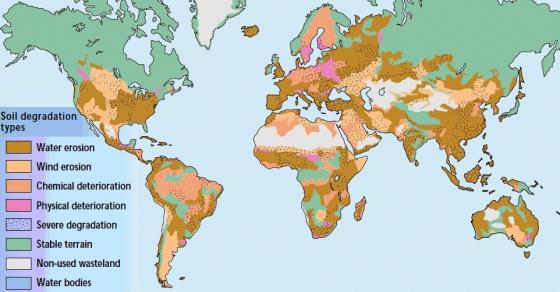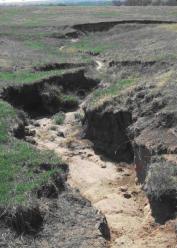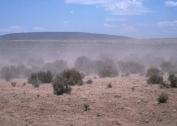Introduction
(Adapted from BALLAYAN 2000 and INFONET-BIOVISION 2010)
Soil degradation is a global process, but affects arid and semi-arid zones in sub-Saharan Africa most. Soil degradation is increasing worldwide, especially in the countries within the tropics. Depletion of nutrients and soil organic matter and erosion are the principal forms of soil degradation (see also nutrient requirements).
Among the land used for agriculture and forestry, soil is an important component. The intensive and increasing pressure on land leads to its degradation and pollution, which may result in a partial or complete loss of its productive capacity. Soil degradation can be defined as a process by which one or more of the potential ecological functions of the soil are harmed or destroyed. Soil degradation is a process that lowers the current and/or future capacity of the soil to produce goods and services.
Soil degradation can be either a result of natural hazards or due to unsuitable land use and inappropriate land management practices. Mismanagement of arable areas by farmers, cultivation practices that are not adapted to local environments and overgrazing by livestock are seen as the major causes of soil degradation.
Natural hazards which can lead to soil degradation include land topography and climatic factors such as steep slopes, frequent floods and tornadoes, blowing of high velocity wind, rains of high intensity and drought conditions in dry regions. The most prominent degradation feature worldwide is erosion by water.
Cultivating and managing soils in a more sustainable way would reduce environmental pressures all over the world: When crops are harvested, organic material and nutrients are removed from the fields (see also the nutrient cycle). While artificial fertilisers replace - to some extent - the loss of nutrients, they do not replace the loss of organic material. Over time, this seriously reduces soil quality, leading to soils with a lower water holding capacity, less air, and soils that are more susceptible to erosion and hence also degradation.

Human-induced soil degradation around the world. Source: ISRIC et al. (1996)
Types of soil degradation
Soil degradation can be classified into four main types of degradation: water erosion, wind erosion, chemical deterioration and physical deterioration.
Water erosion
(Adapted from BALLAYAN 2000 and INFONET-BIOVISION 2010)
Water erosion means that soil particles are detached either by splash erosion (caused by raindrops), or by the effect of running water. Water erosion is influenced by four factors: rainfall, soil type, slope gradient, and soil use/vegetation cover (INFONET-BIOVISON 2010).
- Rainfall: The impact of raindrops on the soil surface can break down soil aggregates and disperse the aggregate material over the surface. Lighter aggregate materials such as very fine sand, silt, clay and organic matter can be easily removed by the raindrop splash and runoff water. Greater raindrop energy or runoff amounts might be required to move the larger sand and gravel particles. Runoff can occur whenever there is excess water on a slope that cannot be absorbed into the soil or trapped on the surface. The amount of runoff can be increased if infiltration is reduced due to soil compaction, crusting or freezing.
- Soil type: Soil erodibility is an estimate of the ability of soils to resist erosion, based on the physical characteristics of each soil type. In general, soils with faster infiltration rates, higher levels of organic matter and improved soil structure have a greater resistance to erosion. Sand, sandy loam and loam-textured soils tend to be less erodible than silt, very fine sand, and certain clay textured soils.
- Slope gradient: Naturally, the steeper the slope of a field, the greater the amount of soil loss from erosion by water. Soil erosion by water also increases as the slope length increases due to the greater accumulation of runoff.
- Soil use: Plant and residue cover protects the soil from raindrop impact and splash, tends to slow down the movement of surface runoff and allows excess surface water to infiltrate.

Example of gully erosion. Source: PLANT and SOIL SCIENCES ELIBRARY (2005)
There are four different types of water erosion (BALLAYAN 2000):
- Sheet erosion: This means when a fairly uniform layer of soil is removed over an entire surface area.
- Rill erosion: This occurs where water runs in very small channels over the soil surface, with the abrading effect of transported soil particles causing deeper incision of the channels into the surface.
- Gully erosion: This type of erosion occurs when rills flow together to make larger streams. They tend to become deeper with successive flows of water and can become major obstacles to cultivation.
- Bank erosion: This is caused by water cutting into the banks of streams and rivers. It can be very serious at times of large floods and cause major destruction to property.
Wind erosion
(Adapted from SHELTON 2003)

Wind erosion in New Mexico. Source: RITTER (2003)
The rate and magnitude of soil erosion by wind is influenced by the following factors:
- Erodibility of soil: Wind can suspend very fine particles and then transport it over great distances. Fine and medium size particles can be lifted and deposited, while coarse particles can be blown along the surface (commonly known as the saltation effect).
- Soil surface roughness: Soil surfaces that are not rough or ridged offer little resistance to the wind. However, over time, ridges can be filled in and the roughness broken down by abrasion to produce a smoother surface susceptible to the wind.
- Climate: The speed and duration of the wind has a direct connection to the extent of soil erosion. Soil moisture levels can be very low at the surface during periods of drought, thus releasing the particles for transport by wind.
- Vegetative cover: The lack of permanent vegetation cover in certain locations has resulted in extensive erosion by wind. Loose, dry, bare soil is the most susceptible. The most effective vegetative cover for protection should include an adequate network of living windbreaks combined with good tillage, residue management, and crop selection.
Chemical deterioration
(Adapted from FAO/AGL 2000)
Chemical deterioration as a type of soil degradation involves loss of nutrients or organic matter, salinisation, acidification, soil pollution, and fertility decline. The removal of nutrients reduces the capacity of soils to support plant growth and crop production and causes acidification. In arid and semi-arid areas problems can arise due to accumulation of salts, which impedes the entry of water in plant roots. Soil toxicity can be brought about in a number of ways. Typical examples are from municipal or industrial wastes, oil spills, the excessive use of fertiliser, herbicides and insecticides, or the release of radioactive materials and acidification by airborne pollutants.
Chemical deterioration of soils is often also due to agricultural over exploitation, relying solely on replenishing nutrient losses through harvesting by artificial fertilisers. Artificial fertilisers most often not able to balance all nutrients, leading to an imbalance in soil. They are also not able to replenish the loss of organic matter, which is important for nutrient absorption. Furthermore, artificial fertilisers can be polluted (e.g., phosphate rock is often radioactively contaminated).
Physical deterioration
(Adapted from FAO/AGL 2000)
Physical deterioration involves soil crusting, sealing and compaction and can be caused by several factors like compaction through heavy machines or animals. This problem occurs in all continents, under nearly all climates and soil physical conditions, but has increased with the use of heavy machinery. Soil crusting and compaction tend to increase runoff, decrease the infiltration of water into the soil, prevent or inhibit plant growth and leave the surface bare and subject to other forms of degradation. Severe crusting of the soil surface because of breakdown of soil aggregates can inhibit water entry into the soil and prevent seedling emergence.
Human causes of erosion
(Adapted from ACS Distance Education 2009)
The following list gives an overview of human actions which can cause erosion and therefore lead to soil degradation:
- Poor agricultural practices such as ploughing soil to support cultivated plants or ploughing soil in areas where rainfall is insufficient to support continuous plant growth.
- Exposing soil on slopes.
- Removal of forest vegetation.
- Overgrazing.
- Altering the characteristics of streams which cause bank erosion.
- Causing increased peak water discharges (increased erosion power) due to changes in hydrological regimes, by such means as altering the efficiency of channels (channel straightening).
- Reducing evapotranspiration losses as a consequence of vegetation removal.
- Production of impervious surfaces such as roads and footpaths, preventing infiltration into the soil and causing increased runoff into streams.
Control of erosion
(Adapted from ACS Distance Education 2009)
As erosion is caused by the effects of wind and water, control methods are generally aimed at modifying these effects. The following list describes some of the most common control methods:
- Prevention of soil detachment by the use of cover materials such as plants.
- Crop production techniques (e.g. fertilising with organic fertiliser), to improve soil characteristics and promote plant growth and hence surface cover.
- Ploughing to destroy rills and contour planting to create small dams across a field, to retard or impound water flow.
- Filling small gullies with mechanical equipment or conversion into a protected or grassed waterway.
- Terracing of slopes to reduce rates of runoff.
- Prevention of erosion in the first place by careful selection of land use practices.
- Conservation tillage methods.
- Armouring of channels with rocks, tyres, concrete and timber to prevent bank erosion.
- The use of wind breaks to modify wind action.
- Ploughing into clod sizes too big to be eroded, or ploughing into ridges.
Conclusion
Soils are the basis for the production of food. The area of arable land is limited. Given the growing world population and the area of soils that are already degraded, sustainable land management is crucial. Sanitation practices that reuse nutrients and organic matter present in wastewater and excreta could contribute largely to sustainable soil management, as they are not only able to balance nutrient losses, but also replenish organic substances that are lost through harvesting.
Soil Degradation
Soil Degradation. ESCAP environment statistics course
This document explains how to measure soil degradation and describes different static tools for this purpose.
BALLAYAN, D. (2000): Soil Degradation. ESCAP environment statistics course. Rome: FAO URL [Accessed: 06.10.2010]Management of Degraded Soils in Southern and eastern Africa (MADS-SEA-Network)
An Introduction to soil degradation
This website gives a very good introduction to soil degradation and explains the different degradation types.
INFONET-BIOVISION (2010): An Introduction to soil degradation. Zurich: Biovision URL [Accessed: 06.10.2010]Picture of Gully Plug Erosion
Soil Erosion - Causes and Effects
The Physical Environment. An Introduction into Physical Geography
Human Induced Soil Degradation
Human activities have often led to degradation of the world’s land resources. This map gives you an overview.
ISRIC ; UNEP ; FAO (1996): Human Induced Soil Degradation. Rome: World Food Summit URL [Accessed: 27.03.2012]Soil Degradation. ESCAP environment statistics course
This document explains how to measure soil degradation and describes different static tools for this purpose.
BALLAYAN, D. (2000): Soil Degradation. ESCAP environment statistics course. Rome: FAO URL [Accessed: 06.10.2010]Human Induced Soil Degradation
Human activities have often led to degradation of the world’s land resources. This map gives you an overview.
ISRIC ; UNEP ; FAO (1996): Human Induced Soil Degradation. Rome: World Food Summit URL [Accessed: 27.03.2012]http://www.infonet-biovision.ch
This website contains information about conservation agriculture techniques and sustainable soil management.
http://www.acsgarden.com/
This online course on Soil Degradation gives a general overview of soil degradation especially focused on soil erosion.
http://maps.grida.no/theme/freshwater
This website contains a number of high-quality maps on different subjects, amongst them also on freshwater availability, water scarcity etc.

